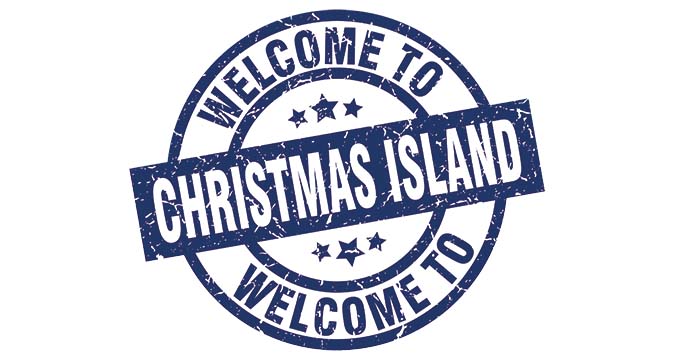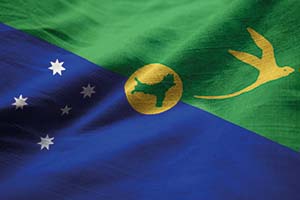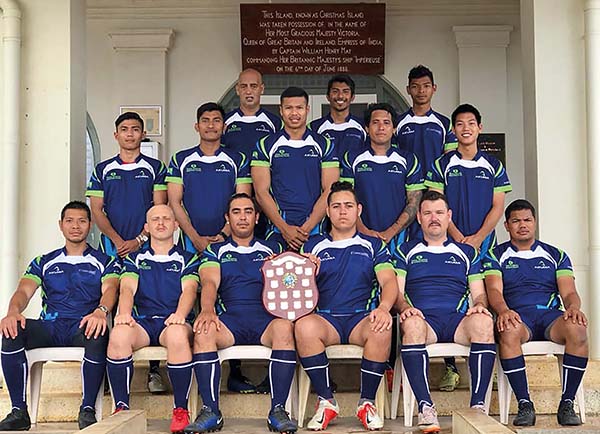
If you had it in your head that Christmas Island was a fictitious land full of elves and reindeers, you’re not alone. So did I, until now. But it’s not. Take my word for it, it’s far from it.
It only took a speculative Google of the phrase ‘Christmas Rugby League’ to uncover a picturesque Australian territory in the Indian Ocean some 1550km North of the Australian mainland.
Its population stands at roughly 1800 people, with a staggering ratio of marine life to people. The endemic Red Crab is the economic linchpin of the island, with over 40,000,000 documented crabs around their shores. That means there’s 22,000 Red Crabs per person.

And despite being such a small island, with an area of just 52 square miles, its inhabitants have formed an immensely diverse universe of their own. Many of the population are of Malaysian/Chinese descent. Language ranges from English, Malay to a number of Chinese dialects.
An intriguing dynamic for such a small island, made all the more astonishing by the fact it was only discovered in 1615.
It was given its unusual name on Christmas Day 1643 by Captain William Myners. Forget reindeers, elves and Santa, that is its only connection with the festive period.
It was settled in the 19th century, and a third of the population now live in the capital city Flying Fish Cove. It has been an Australian territory since 1958.
Barring its name, it is mostly known for having monsoonal forest and also being a hotbed for phosphate mining, its main and often solitary form of industry.
As I delve deeper it’s apparent that the sporting scene is one that isn’t booming, at first sight. The word ‘sport’ doesn’t actually feature in the Wikipedia page at all. Never mind Rugby League.
But, surely, a former British settlement which is now under sovereignty of Australia must have a Rugby League scene? I know the population density isn’t on its side, but there’s always sevens.
I was right to assume that Rugby League exists here: there are almost 2,000 inhabitants and it only takes a couple of Rugby League fanatics to get even a remote island playing the game.

Step forward Tim Briggs, who along with fellow islander Kele Nabukete, set up the island’s first Rugby League team known as Christmas Island Robbers in 2016, with the help of NRL Western Australia.
“Initially I started a fitness program based on Rugby League training skills, drills incorporating basic techniques,” explained Briggs. “Running, ball carrying, fending off, stepping; this was very well received and had 35-40 participants ranging from 14 to 62 years old. From here we had enough guys wanting to learn more of the game and play.”
The inaugural game for the Robbers came against Cocos Keeling Island, a neighbouring island just south east of Christmas Island. The fixture managed to take place after Briggs, who is coach and captain of the Robbers, personally approached the Island Sports Committee about making Rugby League part of the island’s Territory Week.
Territory Week is a seven-day long carnival held in the first week of October, which marks when the sovereignty of Christmas Island was transferred from the UK to the Commonwealth of Australia.
Since the first game in 2016 which was played with nine players, where Cocos took the bragging rights, the Inter-Island Shield has become an annual fixture for the Robbers.
A clear growth has taken place in the number of fixtures held: 23 islanders now play the game of Rugby League actively and over the last three years the NRL WA, Department of Sport and Recreation and Christmas Island’s committee have worked tirelessly to raise the profile of the sport.
“Cocos Keeling Island had a big fascination for Rugby League, rugby union and touch rugby,” explained Briggs, who’s partner Vanessa Goh is the treasurer of the Christmas Island Robbers.
“From there we developed an Inter-Island Rugby League Shield match to be played between the two islands on their anniversary dates, for Christmas Island this is in October and for Cocos it is in April.
“Support has grown and continues to grow on both Christmas and Cocos from the inaugural game of 9s, we now field 13 a side and reserves are around 10-12 per team.
“Support from the community has been the biggest surprise with Christmas Island being traditionally cricket, AFL and soccer mad.
“We have been blown away that all our events have a huge following and attendances and local businesses contact Christmas Island Robbers wishing to become sponsors which is tremendous.
“The inter-island pride of holding the shield continues to bring young and older guys out to play, women are also showing a lot of interest on both islands and this will soon become an addition to future games.”
For an island of such low population density, the future plans are vast. Briggs and co have beaten the odds to get an island of under 2,000 people playing Rugby League at all. Now 1 in 100 people on the island are playing the sport, and he can be forgiven for dreaming big.
The next step? Taking Christmas Island Robbers beyond the island itself, showcasing their journey to the masses.
“Our vision for the future is to continue with the development of Rugby League on Christmas Island and Cocos and working with NRL WA looking at possibilities of an Indian Ocean Rugby League Conference competition of some sort,” added Briggs.
“Malaysia is only a 45 minute flight away from Christmas Island and this could be the next step. The ultimate goal is to get talent recognised and looked at by NRL clubs for possible trials, and eventually on the bigger stage.
“Spreading our scope to Malaysia and Australia is the first step to achieve that dream.
“Logistically, Christmas Island is so far from mainland Australia, and with only two flights a week that makes it hard. The airfare from Perth to here also has its issues at approximately $1800 plus. Add to this that the weather can be our biggest issue with tropical wet and dry seasons, where the wet season can bring cyclones, winds and thunder.”
Christmas Island with bad weather. How fitting.
First published in Rugby League World magazine.
